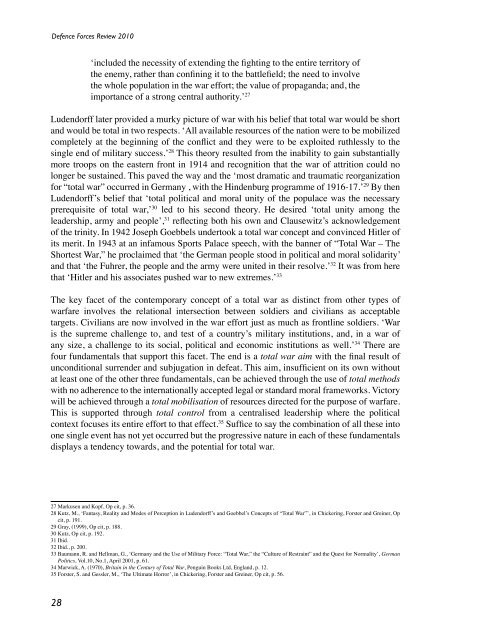Defence Forces Review 2010
Defence Forces Review 2010
Defence Forces Review 2010
Create successful ePaper yourself
Turn your PDF publications into a flip-book with our unique Google optimized e-Paper software.
<strong>Defence</strong> <strong>Forces</strong> <strong>Review</strong> <strong>2010</strong>‘included the necessity of extending the fighting to the entire territory ofthe enemy, rather than confining it to the battlefield; the need to involvethe whole population in the war effort; the value of propaganda; and, theimportance of a strong central authority.’ 27Ludendorff later provided a murky picture of war with his belief that total war would be shortand would be total in two respects. ‘All available resources of the nation were to be mobilizedcompletely at the beginning of the conflict and they were to be exploited ruthlessly to thesingle end of military success.’ 28 This theory resulted from the inability to gain substantiallymore troops on the eastern front in 1914 and recognition that the war of attrition could nolonger be sustained. This paved the way and the ‘most dramatic and traumatic reorganizationfor “total war” occurred in Germany , with the Hindenburg programme of 1916-17.’ 29 By thenLudendorff’s belief that ‘total political and moral unity of the populace was the necessaryprerequisite of total war,’ 30 led to his second theory. He desired ‘total unity among theleadership, army and people’, 31 reflecting both his own and Clausewitz’s acknowledgementof the trinity. In 1942 Joseph Goebbels undertook a total war concept and convinced Hitler ofits merit. In 1943 at an infamous Sports Palace speech, with the banner of “Total War – TheShortest War,” he proclaimed that ‘the German people stood in political and moral solidarity’and that ‘the Fuhrer, the people and the army were united in their resolve.’ 32 It was from herethat ‘Hitler and his associates pushed war to new extremes.’ 33The key facet of the contemporary concept of a total war as distinct from other types ofwarfare involves the relational intersection between soldiers and civilians as acceptabletargets. Civilians are now involved in the war effort just as much as frontline soldiers. ‘Waris the supreme challenge to, and test of a country’s military institutions, and, in a war ofany size, a challenge to its social, political and economic institutions as well.’ 34 There arefour fundamentals that support this facet. The end is a total war aim with the final result ofunconditional surrender and subjugation in defeat. This aim, insufficient on its own withoutat least one of the other three fundamentals, can be achieved through the use of total methodswith no adherence to the internationally accepted legal or standard moral frameworks. Victorywill be achieved through a total mobilisation of resources directed for the purpose of warfare.This is supported through total control from a centralised leadership where the politicalcontext focuses its entire effort to that effect. 35 Suffice to say the combination of all these intoone single event has not yet occurred but the progressive nature in each of these fundamentalsdisplays a tendency towards, and the potential for total war.27 Markusen and Kopf, Op cit, p. 36.28 Kutz, M., ‘Fantasy, Reality and Modes of Perception in Ludendorff’s and Goebbel’s Concepts of “Total War”’, in Chickering, Forster and Greiner, Opcit, p. 191.29 Gray, (1999), Op cit, p. 188.30 Kutz, Op cit, p. 192.31 Ibid.32 Ibid., p. 200.33 Baumann, R. and Hellman, G., ‘Germany and the Use of Military Force: “Total War,” the “Culture of Restraint” and the Quest for Normality’, GermanPolitics, Vol.10, No.1, April 2001, p. 61.34 Marwick, A. (1970), Britain in the Century of Total War, Penguin Books Ltd, England, p. 12.35 Forster, S. and Gessler, M., ‘The Ultimate Horror’, in Chickering, Forster and Greiner, Op cit, p. 56.28
















